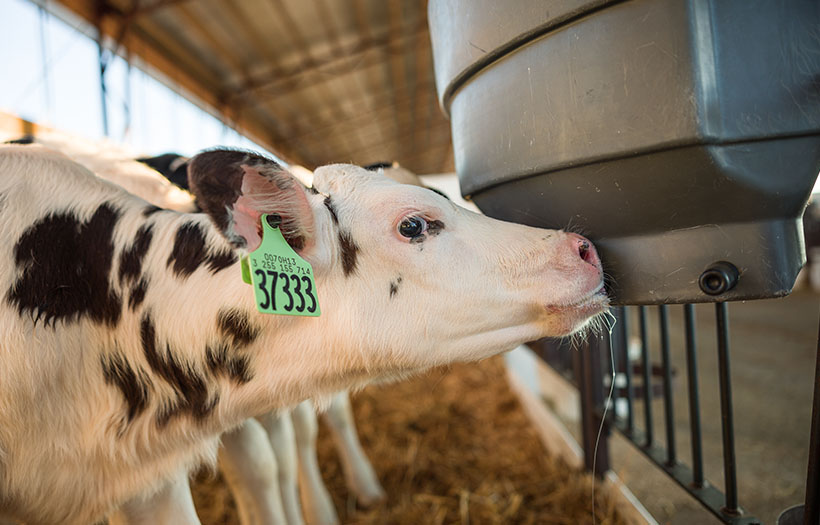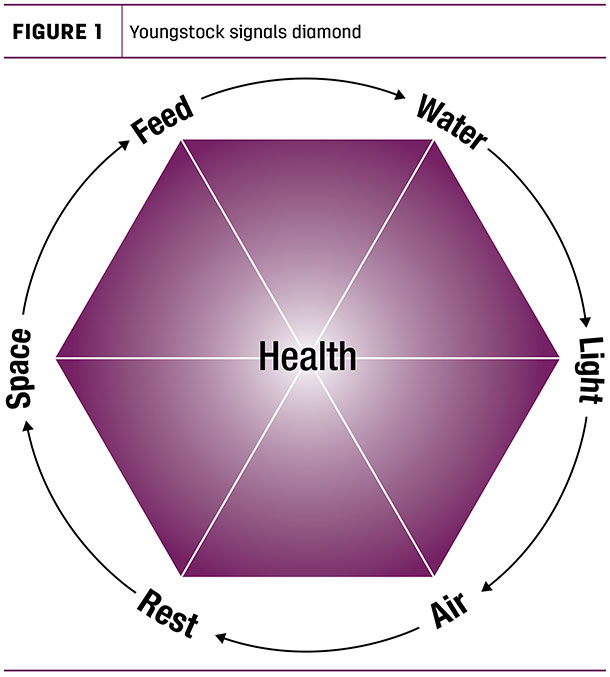Know the six signals to monitor in youngstock

Successful calf and heifer raising can be measured in a few ways. Ultimately, the investment put into replacement animals results in a reduced age at first calving (optimum target of 22 to 24 months), leading to lower costs as fewer heifers are raised and higher returns due to greater lifetime profitability.
Figure 1 identifies six critical areas that may either limit or enable replacement heifers to reach their full genetic potential.

Providing these six freedoms daily ensures maximum health, growth and development, and ultimately a greater return on investment.
1. Feed
Clean, consistent, convenient. Optimal heifer-feeding programs start during the dam’s gestation and run up until the day the heifer has a calf of its own. While a heifer’s nutritional needs vary over time, optimal feeding throughout this entire time period will yield best results.
Colostrum feeding is the most important feeding calves will receive. This feeding sets calves up for success if delivered at the right time (within one hour of calving), in the right quantity (4 litres) and at the best quality (+22 Brix).
Calves convert nutrients into growth most efficiently from zero to 6 months old, providing you with your best return on investment during this phase. Fermented feeds should be introduced post-weaning, and diets should be formulated for every stage of growth.
2. Rest
Maximizing lying times in youngstock is an essential element for growth. Limited rest time results in immunosuppression, decreased feed intakes and poor reproduction.
In environments with limited rest, growth of individuals will suffer. Come breeding time, those easy-to-breed heifers will be a struggle.
Bedding has an important impact on lying times, especially as we move toward colder months. To maximize lying times, consider increasing bedding and evaluate nesting scores.
You can measure the temperature of the nesting microclimate (ideally at 16ºC), which is a quick and easy way to evaluate if the calves are comfortable and sufficiently warm.

3. Space
Space is king, as it is a precursor for rest and impacts the level of competition in a herd. Calves up to pregnant heifers require 32 to 70 square feet (dependent on facility type).
Insufficient space is a stressor which will accentuate any pre-existing dominant or submissive behaviour in replacement heifers.
Competition is further compounded by any weaning stress experienced and by variability in age and size of animals in a group.
Crowding is correlated with increased age at first calving (25 to 27 months). Optimizing space enables tracking of heats, cleaner heifers, fewer injuries and superior growth.
4. Water
Water is the most important nutrient for replacement animals. Availability is key; think not only access but also flow and cleanliness – if you won’t drink it, neither will she.
Heifers require 1 to 3 inches of water access each (dependent on age) and a minimum flow of 15 litres per minute.
Younger calves that are bottle- or bucket-fed require access to water 24 hours a day. Do not offer water in the same bucket as milk feeding, and wait to offer water until 30 minutes after calves are fed milk.
5. Light
While we don’t think of light being as crucial in the success of our replacement animals as it is for lactating cows, it in fact plays the same role it does in mature animals.
Heifers require 16 hours of light per day at 200 lux to maximize feed intakes, growth and reproduction. Furthermore, calves and heifers raised in dark barns tend to be overlooked during day-to-day chores.
6. Air
When we talk about air quality and ventilation in calf and heifer facilities, there are many options: positive-pressure, tunnel ventilation, calf hutches and open-faced heifer housing.
Heifers will exhibit specific air-seeking behaviour when ventilation is sub-optimal. This behaviour includes heifers grouping under or by fans, uneven animal distribution in the barn or long periods of standing and perching.
To improve ventilation in heifer facilities, air must be distributed evenly to each calf.
Lower air speeds should be used in colder weather (60 feet per minute), while increased air speeds should be used in warmer weather (200 to 300 feet per minute), and drafts should be eliminated at all times.
Successful calf and heifer raising starts before calves are born and continues until the day of calving. The six freedoms must be met in order for replacement animals to meet their full genetic potential.
Growth, health and reproduction will depend on these freedoms and, ultimately, will impact lifetime productivity.
The future of your business depends on the calves born into your herd today and how they will be raised over the next 23 months. Making the correct investment will yield the highest returns; it will be worth the wait.
PHOTO: Nesting score = 1: Legs entirely visible when lying down. Nesting score = 2: Legs partially visible when lying down. Nesting score = 3: Legs generally not visible when lying down.
